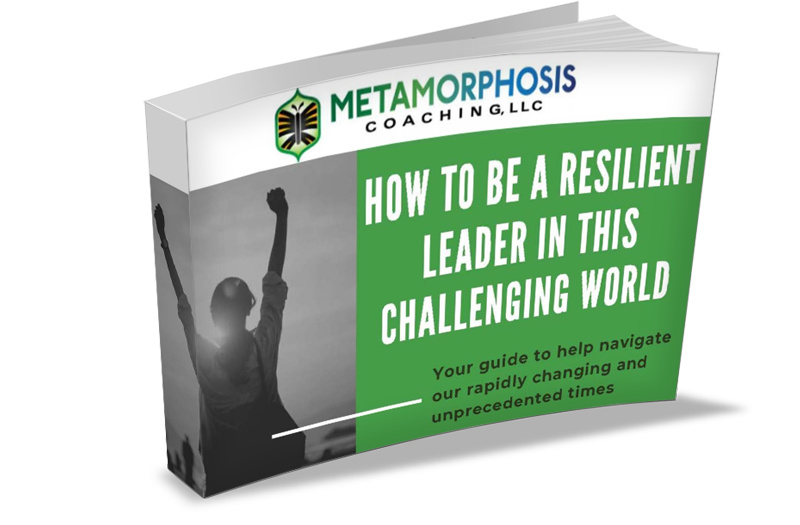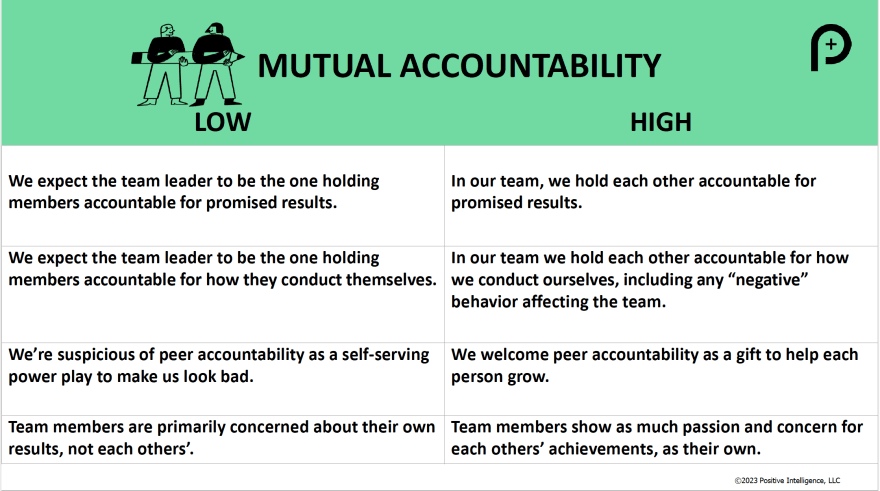Mutual Accountability – What, Why, How in Your Organization (Part 4 of 4)

Mutual Accountability – What, Why, How in Your Organization
Part 4 of a 4-Part Series
by Doni Landefeld, Ph.D.
Advanced Certified Personal and Executive Coach
Certified Positive Intelligence Coach
EQ-i 2.0 and EQ360 Certified
May 2023
Imagine a culture where team members care as much about their colleagues’ successes as they do their own, including the journey or path toward achievement. The journey will most likely have some bumps in the road and yet, regard and respect for one another is so high, that team members are delighted to pause their work and take some time to help the colleague who runs into an obstacle in the road. With this regard also comes the tacit understanding that there is a reciprocal “lifting up” of one another that includes calling out any negativity or limiting beliefs that will surely sabotage team initiatives.
This month we’re focusing on mutual accountability, the fourth pillar to building high-powered, highly-functioning teams. Fostering mutual accountability initially begins with the team leader and then blossoms into a flattened hierarchy where everyone assumes the role of being equal partners. Mutual accountability occurs when the leader creates a culture where everyone holds each other accountable for both results and conduct.
Conduct can be positive, negative or lie somewhere in between the two poles. As with any behavior, we spread sage contagion when we model what we want to see in others and reinforce desired behavior through recognition and celebration. So, to get even more positivity, model and exude a positive outlook, publicly recognize and celebrate behaviors and outcomes when they are moving the organization forward. When the opposite occurs, and behaviors are not conducive to desired results, it’s very important to separate the behavior from the individual. Many leaders fall into this trap and forget to isolate the problem from the individual. Call out what you see and ask how you may support the individual to help them course correct (e.g., “Sally, I’m noticing that you appear frustrated and didn’t deliver the Profit and Loss statement during the date we all agreed upon. How may I help you?”). Always come from a place of support and positivity, and never ever publicly criticize.
When conduct is managed, desired results happen more effortlessly. There are a few other ingredients, however, to establish mutual accountability to drive results:
1. Co-creation – just like a healthy coaching and consulting engagement, giving everyone the opportunity to reverse engineer a project from end to beginning will garner more buy-in and motivation. This is a time to keep the controller saboteur at bay so everyone feels safe and inspired to take initiative. Using the sage power of navigate is an appropriate strategy to use to focus on what matters most and how the team will be addressing pain points or potential obstacles.
2. Establish agreements over expectations – let’s tip our hat to the great Steve Chandler for this strategy which is brilliant. So many organizations use the term “expectations” in anything from job descriptions to project deliverables to operations. Expectations breed toxicity and mistrust because they imply a powerplay. If a team is to feel safe to hold one another accountable, the healthier way to do this is to create agreements with one another and for the team overall. Co-creation is then taking place and the agreement represents a “contract” which can be amended or revisited if a bump in the road occurs.
3. Vulnerability – is always the most important ingredient to generate trust. There are hundreds of ways to demonstrate vulnerability and one of my favorites is when a leader admits that they don’t have an answer [yet] and are working, reflecting, or researching to find a possible solution at which time they’ll go back to the team to bounce the idea around.
4. Using a coaching approach – identified as one of the top 5 most important competencies that a leader needs to adopt in the year ahead (from the Brandon Hall group), is to grow team members through a coach approach. This involves asking questions to help team members tap into their inner wisdom to move forward. Instead of a leader being a ‘sage of the stage’, solving problems, it’s more about being a guide on the side to empower, transform behavior and do so in a way that motivates each individual team member.
5. Defer to praise and positivity – mentioned in a previous paragraph discussing conduct, we get what we give. If we model positivity, we will experience even more of it and invite more creativity and innovation. This fuels results. Publicly celebrate, privately counsel.
Once these elements are incorporated, mutual accountability will get traction. Then, it’s just a matter of fine-tuning and looking for ways to rinse, repeat and update as projects evolve or as the team grows.
Curious about contrasting low vs high mutual accountability? The following chart provides examples:
If you’re familiar with Patrick Lencioni’s model of high-performing teams, you no doubt see many parallels made in what we’ve presented in this article, as well as the previous 3 pillars. Achieving and using all 4 pillars drives desired results. And you also have 5 strategies from this article to establish mutual accountability. To this, and as a bonus, we may add three emotional intelligence skills to leverage: assertiveness, self-regard and impulse control.
Assertiveness is important in any form of team-building or negotiating; we always want to avoid aggressiveness or passivity.
Self-regard is important to know yourself so you may be able to connect with and understand others (empath).
And impulse control is critical to regulate and temper what may or may not be appropriate to express.
So, we’ve now covered all four leadership pillars necessary for creating high-powered teams. If you missed one or more or would like to unpack how they might exist in your organization, let’s connect. There’s a team assessment we include as part of our Positive Intelligence program with the High-Powered Teams component. And for those of you who did the foundational Positive Intelligence program, recall how your saboteur assessment results were uncanny – so just imagine what can come out in the team assessment! Going from ‘me’ to ‘we’!
Here’s a recap of the 4 pillars of High-Powered Teams:
- Triple Purpose (we covered in February’s newsletter)
- Earned Trust (March’s newsletter)
- Healthy Conflict (April’s newsletter)
- Mutual Accountability (May)
Did you know there’s a program for your team or organization to learn and master the Four Pillars of High-Powered Teams and Leadership? It begins with a 7-week foundational Positive Intelligence program and segues into a transformational experience for Leadership Teams and Executives.
If you’d like to learn how to re-energize your team and ignite inspiration, let’s explore your challenges. Schedule your complimentary right-fit session here:
Special Report:
How to be a Resilient Leader in this Challenging World. PLUS More Free Resources!

Sign up below and get your FREE "How to Be a Resilient Leader in This Challenging World" Report today!

